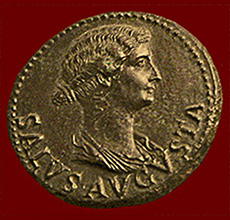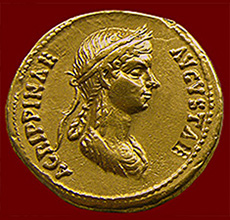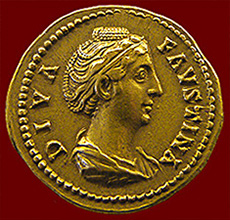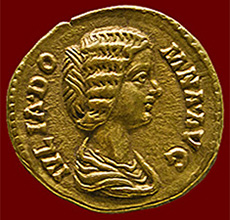 LIVIA AUGUSTA |
 AGRIPPINA MINOR |
 FAUSTINA MAIOR |
 JULIA DOMNA |
 LIVIA AUGUSTA |
 AGRIPPINA MINOR |
 FAUSTINA MAIOR |
 JULIA DOMNA |
Human hair has not changed from antiquity to modern times: it is physically and biologically the same. What has changed are the socially conditioned cultural norms guiding the choices we impose upon on our hair, and the technologies developed to assist the expression of those choices. These changes pose significant challenges to the student of ancient hairdressing.
In the realm of cultural norms, it is customary in the United States of America that women wear their hair shorter than its full, maximal length — especially as they get older. This is especially true for women with naturally curly hair types, since these may be inconvenient to manage on a day to day basis. But Roman women of all ages and all curl types wore their hair as long as they could, and it is upon very long hair that recreation of Roman hairstyles is most effective. In modern times, locating hair models with adequate length in diverse curl textures can be difficult.
As for technology, modern hairdressing is the creature of scientific innovation: by harnessing electricity, chemistry and metallurgy modern women can, at whim, alter fundamental characteristics of their hair to a level where reality and artifice are indistinguishable. The ease with which we moderns routinely alter our hair can blind us to the technical and physical limitations governing hair care in antiquity.
For instance, we moderns take for granted our ability to safely curl our hair with the flick of an electric switch—not so for Roman women. Artificial curling was hazardous but popular. The hair was wrapped around a tapered metal rod called a calamistrum that had been heated in hot ash or open flame — if done carelessly, the hairs could be “melted” right off or scorched to the point where they would break when combed. Once curled, the hair was at the mercy of the local climate: there was little to protect it from rain, humidity, even perspiration — and the hair would inevitably revert to its natural state.
If one strives to recreate ancient hair styles accurately, one must actively forget modern technology and use only those tools known to have been available in ancient times: blunted needles and thread (preferably wool), hair bodkins, wood and bone combs and leaf spring scissors or small knives (to cut excess thread) with water and (olive) oil and beeswax for styling aids. I would admit one anachronism, however: curling. I am willing to accept the anachronism of electric curling irons because I am unwilling to risk harming the model’s hair with a calamistrum heated over flame. It is important not to use the shell of the iron however; simply wind the hair around the implement from root to end.
At all times and in all cultures, the perceived success or failure of a hairstyle will hinge upon the biological hair of individuals. The unique details of each individual’s natural hair resource (i.e., hairline path, density, coarseness, curliness or straightness, color and length), contribute enormously to the viewers’ impression of the hairstyle. Therefore, when examining ancient hairstyles, one must carefully avoid egocentrism and dogmatism. Everybody has hair, but nobody has exactly the same hair as you do, or in the case of anonymous Roman portraits, as the contemporaneous empress portrait used to date them. One must not automatically conclude that hair different from one’s point of reference is artificial, unless close observation, inquiry and experimentation demonstrates it.
Crucial to this inquiry is separating the characteristics attributable to the natural hair resource itself from the set of physical manipulations imposed on that resource, such as cutting, part lines, braids, twisting, artificial curling and focal weight. The interplay of resource and arrangement in hairstyles can be described within three categories: arrangement-based, resource-based and a combination of the two.
In arrangement-based hair fashions, the hair need only be cut, parted, restrained or put up in a particular way to be perceived as fashionable. The best modern example of arrangement-based fashion is the 1920’s bobbed hairstyle: it made no difference what color, coarseness or curl one had—provided it was short. In Roman times, arrangement-based fashions were common, a prime example being the nodus style; characterized by a roll of hair over the forehead and a bun on the neck, it was made popular during the late Republican and Augustan periods by Augustus' wife Livia (58 BCE-29 CE) and his sister Octavia (69-11 BCE). Here is my recreation of the ancient nodus: side view and back view. Another distinctive arrangement was the looped braid of the empress Agrippina the Younger (15-59 CE), mother of Nero: see my video detailing the process of recreation. Still others are the beehive; the braided french twist of Faustina the Elder (c. 100-140 CE), empress of Antoninus Pius; simple buns like those popularized by their daughter Faustina the Younger (125/130 – 175 CE), wife of Marcus Aurelius; the familiar hairstyle of Julia Domna (170–217 CE), empress of Septimius Severus and mother of the emperor Caracalla, whose serpentine bun I recreated in this video; and the 100-strand braid of the empress Plautilla (c. 185/189-212 CE), the wife of Caracalla, which I also recreated: frontal angle and back view. Arrangement-based fashions usually rely on some type of technology: hairnets, needle and thread and ribbons in Roman times; in modern times implements such as barrettes, bobby pins and “bump-its.”
The second category is the resource-based arrangement: a specific quality of the hair itself, such as color, length or curl is necessary for fashionability, with little concern as to how it is arranged. In the 1950’s platinum blonde and red hair colors were extremely stylish, while curls reigned supreme in the 1980’s—otherwise, there was a wide variety of acceptable arrangements during both decades. The Romans admired lighter than normal hair colors. During the Gallic conquests in particular, some women wore hairpieces constructed from blonde hair cut from war captives, while others chemically lightened their hair with sapo, a primitive lye soap of Gallic invention. For those with less than optimal natural endowments, technologies that influence hair chemistry are most common during resource based fashion periods.
The third category, combination hair fashions, tends toward extremes. These styles will require precise arrangement and a specific set of qualities to the hair itself. In the late 1970’s, the “Farrah Fawcett” hairstyle required length, above average density, a specific haircut, blow drying and artificial curling for its success. Today, many women with ultra-curly hair wear long, pin straight, bluntly cut arrangements that can only be achieved with the help of chemical relaxers and false hair. In Rome, combination fashions dominated the late 1st c. CE during the vogue for tall front hair and enormous wreath buns that required tight curls on the front hair and extreme length in the back, and again with the “tower” hairstyle (another view) of the mid-2nd century CE, which required extreme hair length and density. When combination fashions dominate, women are more likely to add false hair to their styles (see, for example, this girl in a wig).
For more information about and images of Roman empresses, consult the World of State: Imperial Women and De Imperatoribus Romanis
For additional videos of my recreations of ancient hairstyles, see my channel: the most recent additions are "Vestal Hairdressing: Recreating the 'Seni Crines'" and "The Tutulus Hairstyle: ca. 40 BC."